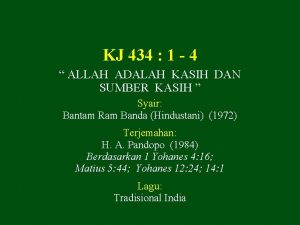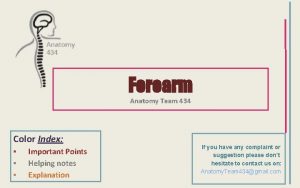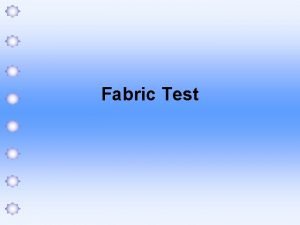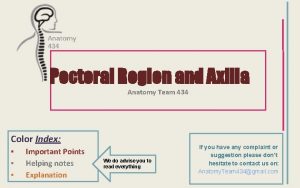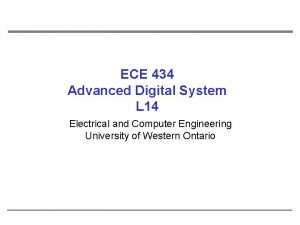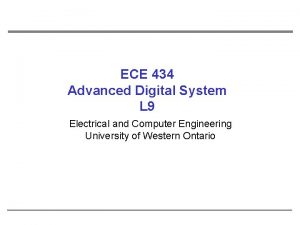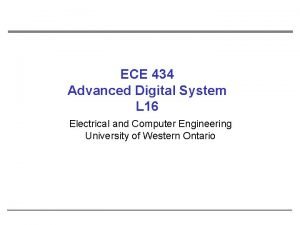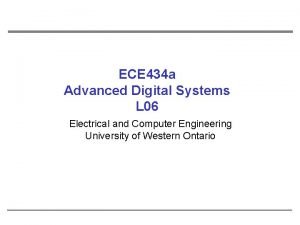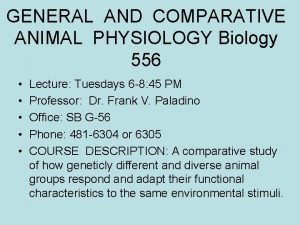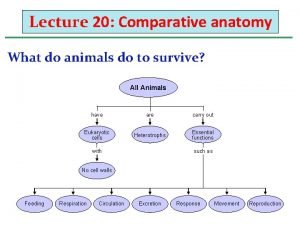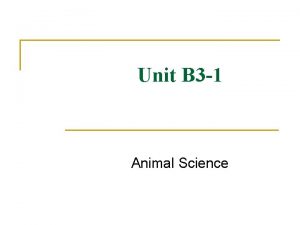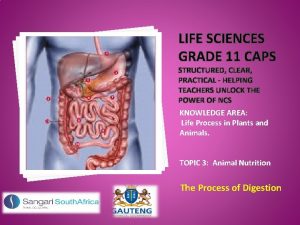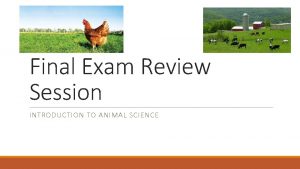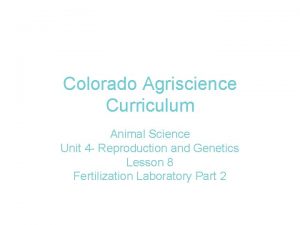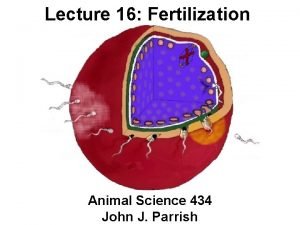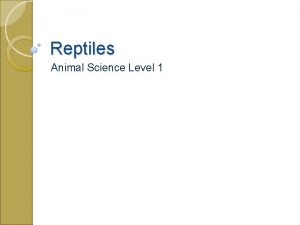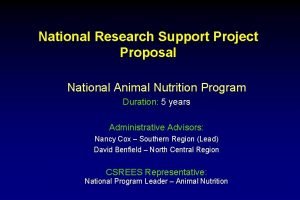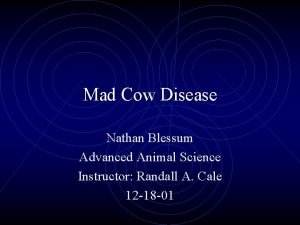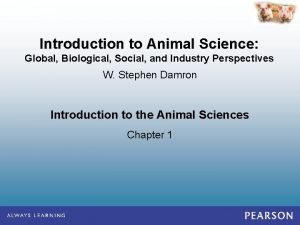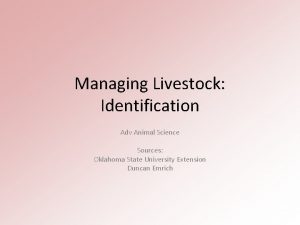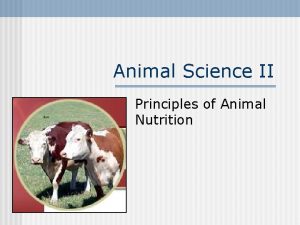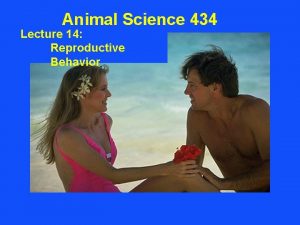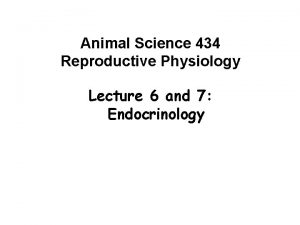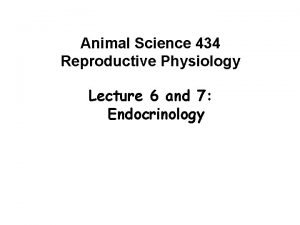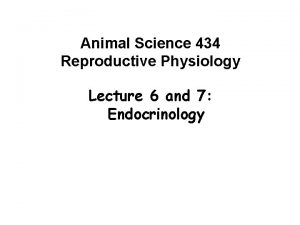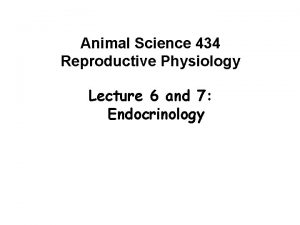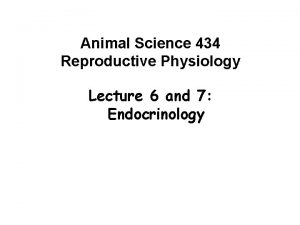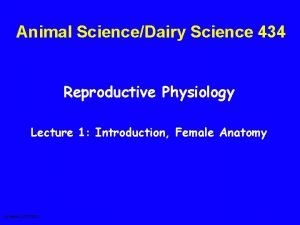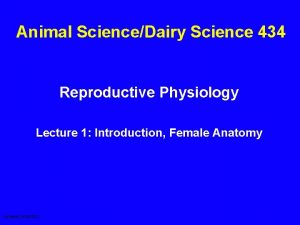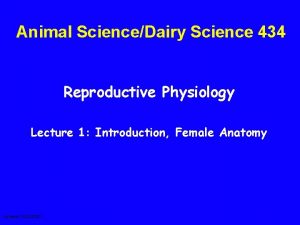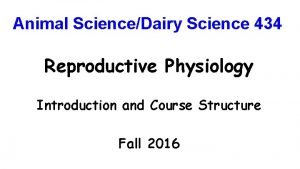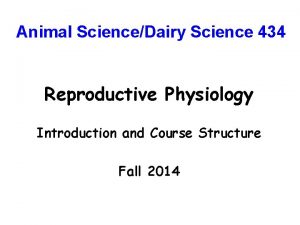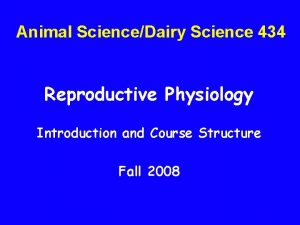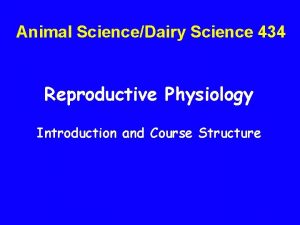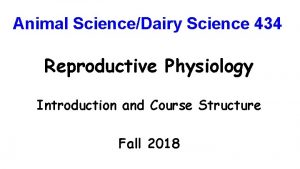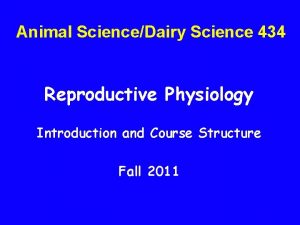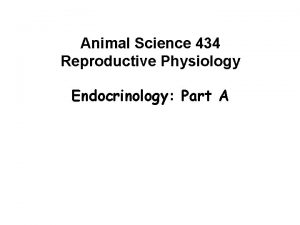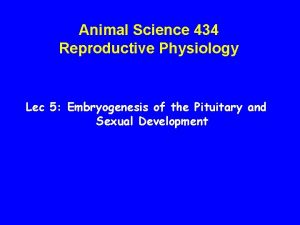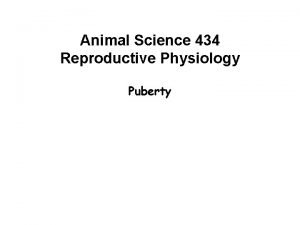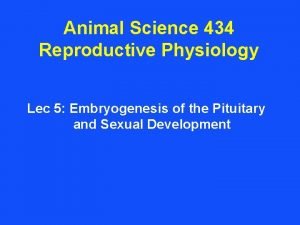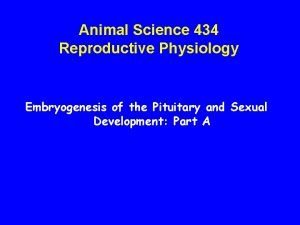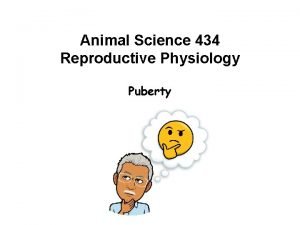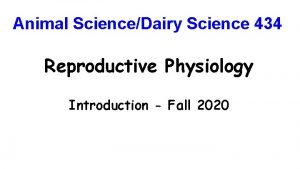Animal Science 434 Reproductive Physiology Lecture 6 and


















































- Slides: 50

Animal Science 434 Reproductive Physiology Lecture 6 and 7: Endocrinology

What is the function of the endocrine system?

Integration of Body Functions • nervous and endocrine systems are similar • nervous system » seconds » minutes and hours • endocrine system

Neuro-endocrine Response

Manipulation of the Endocrine System • Hormones can be used to regulate body functions » growth (anabolic steroids) » lactation (GH or STH) » birth control (Estradiol, Progesterone) » estrous cycle (PGF 2 ) » superovulation and embryo transplant (FSH, e. CG) » parturition (oxytocin)

Endocrine Gland • A ductless gland • Secretes substances (hormones) into blood or lymph that affect cells elsewhere in the body • The secretion does not involve loss of tissue

Exocrine Gland • A gland with ducts that are used for secretion

Hormone • Substance produced by endocrine gland • Acts on cells, tissues or organs at a place • other than where produced Acts as a catalyst.

Endocrine Glands Hypothalamus Pineal Adrenal Ovary Uterus Pituitary Placenta Testes (in bull) Thyroid Pancreas

Classification and Properties of Hormone A. Site of Production B. Type of action 1. Primary hormone of reproduction 2. Metabolic hormone C. Chemical Structure 1. General structure – – Proteins and polypeptides Steroids Fatty acids Modified amino acid 2. Size

Classification and Properties of Hormone A. Site of Production B. Type of action 1. Primary hormone of reproduction 2. Metabolic hormone C. Chemical Structure 1. General structure – – Proteins and polypeptides Steroids Fatty acids Modified amino acid 2. Size

Location of the Hypothalamus and Pituitary Gland

Hypothalamus

Function of Hypothalamus • • • appetite thirst body temperature vasomotor activity emotion use of body nutrient reserves activity of intestine sleep sexual behavior Production and release of releasing hormones

Releasing Hormones of the Hypothalamus A. B. • • Structure short chain polypeptides (3 - 44 amino acids) General Function to cause the release of trophic hormones from the anterior pituitary gland

Releasing Hormones of the Hypothalamus C. Hormones • Gonadotropin releasing hormone (Gn. RH) » LH, FSH release • Thyrotrophin releasing hormone (TRH) » TSH and prolactin release • Corticotrophin releasing hormone (CRH) » ACTH release • Growth hormone releasing hormone (GH-RH) • Somatostatin (growth hormone inhibiting hormone)

Hypothalamus

Hypothalamus Preoptic nuclei cell Nerve Cells Superior hypophyseal artery Capillary plexus Hypophyseal portal vessels Cells of the Anterior Pituitary • • • LH FSH Prolactin STH TSH ACTH Posterior pituitary Capillary plexus


Anterior Pituitary Hormones A. Structure 1. glycoproteins or proteins B. Hormones 1. gonadotropins » Follicle stimulating hormone » Luteinizing hormone (LH) » Prolactin (FSH)

Anterior Pituitary Hormones 2. Other trophic hormones • • • Adrenal Corticotropin (ACTH) thyroid stimulating hormone (TSH) growth hormone (GH or STH)

Structure of LH, FSH and TSH • Made of 2 amino acid chains a S • • S b chains are the same b chains differ and give specificity

Supraoptic nuclei cell Nerve Cells Hypothalamus Paraventricular nuclei cell Capillary plexus Anterior Pituitary Posterior pituitary • Oxytocin • ADH

Hypothalamus Nuclei that produce posterior pituitary hormones

Posterior Pituitary Hormones A. Structure • polypeptides (9 amino acids) B. Hormone • Oxytocin - contraction of smooth muscle

Placental Hormones • Equine » Chorionic Gonadotropin (e. CG) Formation of accessory CL and maintains pregnancy • Human Chorionic Gonadotropin (HCG) » Maintains primate CL and pregnancy » Development of the mammary gland in the mother • Placental • Steroids Lactogen (PL) - Estrogen and Progesterone

Gonadal Polypeptide Hormones • Relaxin » Secreted by CL during pregnancy. » Parturition • Inhibin » Inhibits FSH release

Gonadal Steroids A. General » » Origin - ovary, testis, adrenal Structure

Steroid Cholesterol 27 -C Synthesis Pregnenolone 21 -C OH Estradiol 18 -C HO 19 -C 21 -C Progesterone Testosterone

Gonadal Steroids Cont. A. General Cont. » Solubility – Bound to a binding protein for transport B. Type of Steroids » » » Androgens - Testosterone Estrogen - Estradiol Progestin - Progesterone

Steroid Cholesterol Synthesis Pregnenolone Mitochondria OH Estradiol HO Smooth ER Progesterone Testosterone

Other Hormones A. Prostaglandins 1. PGF 2

Lipid Hormones - Prostaglandins Fatty Acids Prostaglandins Phospholipids 1. Produced by all tissues - Rate limiting (Phospholipase A 2) of body 2. Can have a local effect on tissues (same tissue Arachidonic Acid - Precursor to Prostaglandins which produced it) Cyclo-oxygenase 3. Rapidly degraded in lungs Aspirin inhibits • Vasodilation • Maintain CL • Ovulation • Implantation PGE 2 PGF 2 • Vasoconstriction • CL regression • Ovulation • Parturition • Sperm transport

Other Hormones B. Melatonin 1. Secreted from the pineal gland. 2. Is a modified amino acid 3. Functions to integrate effects of light on reproductive processes.

Other Hormones C. Human Menopausal Gonadotropin (h. MG) 1. Anterior pituitary gland » Secreted in menopause, FSH-like activity » Isolated from urine a. Perganol - superovulation

Classification and Properties of Hormone A. Site of Production B. Type of action 1. Primary hormone of reproduction (FSH, LH, estradiol, progesterone) 2. Metabolic hormone (thyroxin, insulin, STH)

Classification and Properties of Hormone • Chemical Structure » Polypeptides - hypothalamic » Protein - pituitary, gonad » Steroids - gonad, adrenal » Fatty acid - many sources, prostaglandins » Modified amino acid - pineal

Chemical Structure of Hormones polypeptide modified amino acid Gn. Rh melatonin TRH CRH GHRH Somatistatin Oxytocin protein sex steroid fatty acid LH Estradiol PGF 2 FSH Progesterone Prolactin Testosterone ACTH TSH GH or STH Relaxin Inhibin

Chemical Structure of Hormones Molecular size of hormones that regulate reproduction Hormone FSH LH Prolactin HCG e. CG Inhibin Relaxin ACTH Oxytocin Gn. RH Estradiol Testosterone Progesterone PGF 2 Molecular Weight 30, 000 to 37, 000 26, 000 to 32, 000 23, 000 to 25, 000 37, 700 28, 000 >10, 000 6, 500 4, 500 1, 007 1, 200 300 300

Chemical Structure of Hormones Cont. Polypeptide and protein hormones are made of peptide bonds These hormones can not be given orally!

Chemical Structure of Hormones Cont. Steroids PROGESTERONE CORTISOL These hormones can be given orally!

Mechanism of Hormone Action

Mechanism of Hormone Action

Receptor Structure

Mechanism of Hormone Action Protein Hormones (c. AMP second messenger) G Adenylate cyclase phosphorylation of enzymes in steroid synthesis Mitochondria Cholesterol Protein synthesis that regulates steroid synthesis (enzymes)

c. AMP Second Messenger Hormones • Anterior Pituitary Hormones • Placental Hormones » LH, FSH, Prolactin » STH, ACTH, TSH » HCG, e. CG

Protein Hormones (Ca 2+ Second Messenger) Gn. RH Ca Receptor Gn. RH G-protein Plasma Membrane Phosphotidyl Inositol DAG PLC IP 3 Ca R Ca PKC 2+ 2+ Endoplasmic Reticulum Secretory Granules Fusion Plasma Membrane LH 2+

Calcium Second Messenger Hormones • • • Gn. RH » triggers release of LH in anterior pituitary Oxytocin » triggers contractions of smooth muscle PGF 2 » triggers apoptosis of cell » inhibition of progesterone synthesis

Steroid Hormone Action Uterine Growth

Hypothalamus Feedback Loops Neuro-secretory Cells Releasing Hormones Polypeptides Portal Vein - Anterior Pituitary Gonadotropins: FSH, LH Proteins Blood Stream Gonads Receptor on Cell Surface only effects on [ Why ] target organs Cyclic AMP inside cell Steroid Hormone Production { Testosterone Estradiol Progesterone Blood Stream Bound to Protein
 Chapter 2 human reproductive anatomy and physiology
Chapter 2 human reproductive anatomy and physiology Microbial physiology and metabolism lecture notes
Microbial physiology and metabolism lecture notes Luteinizing hormone in male reproductive system
Luteinizing hormone in male reproductive system Teks anatomy and physiology
Teks anatomy and physiology Unit 26 animal anatomy physiology and nutrition
Unit 26 animal anatomy physiology and nutrition Allah adalah kasih dan sumber kasih
Allah adalah kasih dan sumber kasih Anatomy team 434
Anatomy team 434 Astm d 434
Astm d 434 Anatomy team 434
Anatomy team 434 Ece 434
Ece 434 Ece 434
Ece 434 Ece 434
Ece 434 434 x 2
434 x 2 Ece 434
Ece 434 01:640:244 lecture notes - lecture 15: plat, idah, farad
01:640:244 lecture notes - lecture 15: plat, idah, farad Science olympiad anatomy and physiology
Science olympiad anatomy and physiology Science olympiad forensics cheat sheet
Science olympiad forensics cheat sheet Comparative animal physiology notes
Comparative animal physiology notes Manuela gardner
Manuela gardner Animal physiology exam 1
Animal physiology exam 1 Invertebrate digestive system
Invertebrate digestive system Animal female reproductive system diagram
Animal female reproductive system diagram What is my favourite subject
What is my favourite subject Venn diagram animal and plant cells
Venn diagram animal and plant cells Animal rights versus animal welfare
Animal rights versus animal welfare Physical science lecture notes
Physical science lecture notes Venn diagram animal and plant cells
Venn diagram animal and plant cells Natural science and social science similarities
Natural science and social science similarities Science fusion online
Science fusion online Hard and soft science
Hard and soft science Grade 11 life sciences animal nutrition
Grade 11 life sciences animal nutrition Animal science final exam
Animal science final exam Colorado agriscience curriculum
Colorado agriscience curriculum J
J Reptilenesia animal science
Reptilenesia animal science Animal science career cluster
Animal science career cluster Animal science merit badge worksheet
Animal science merit badge worksheet Project proposal in animal science
Project proposal in animal science Advanced animal science
Advanced animal science Advanced animal science
Advanced animal science Damron introduction to animal science download
Damron introduction to animal science download Adv animal science
Adv animal science Principles of animal science
Principles of animal science Upper respiratory system
Upper respiratory system Tattoo anatomy and physiology
Tattoo anatomy and physiology Imperfect flowers examples
Imperfect flowers examples Anatomy and physiology bone
Anatomy and physiology bone Stomach ulcer anatomy
Stomach ulcer anatomy Sheep liver lobes
Sheep liver lobes Hypogastric region
Hypogastric region Epigastric vs hypogastric
Epigastric vs hypogastric





